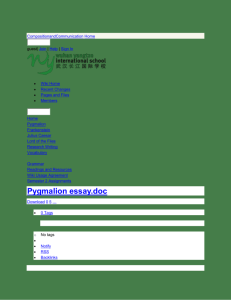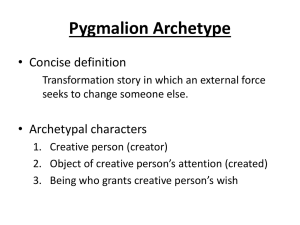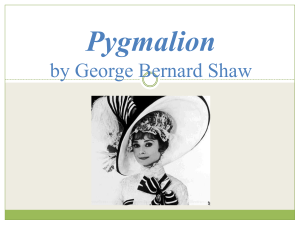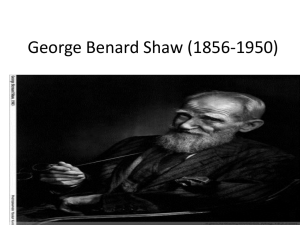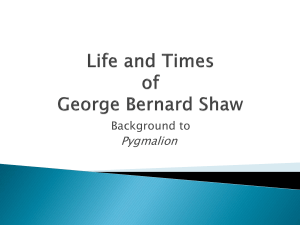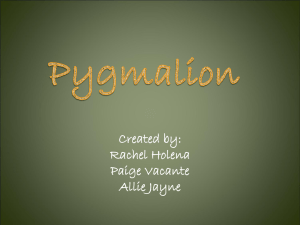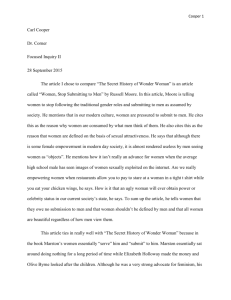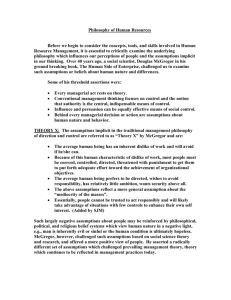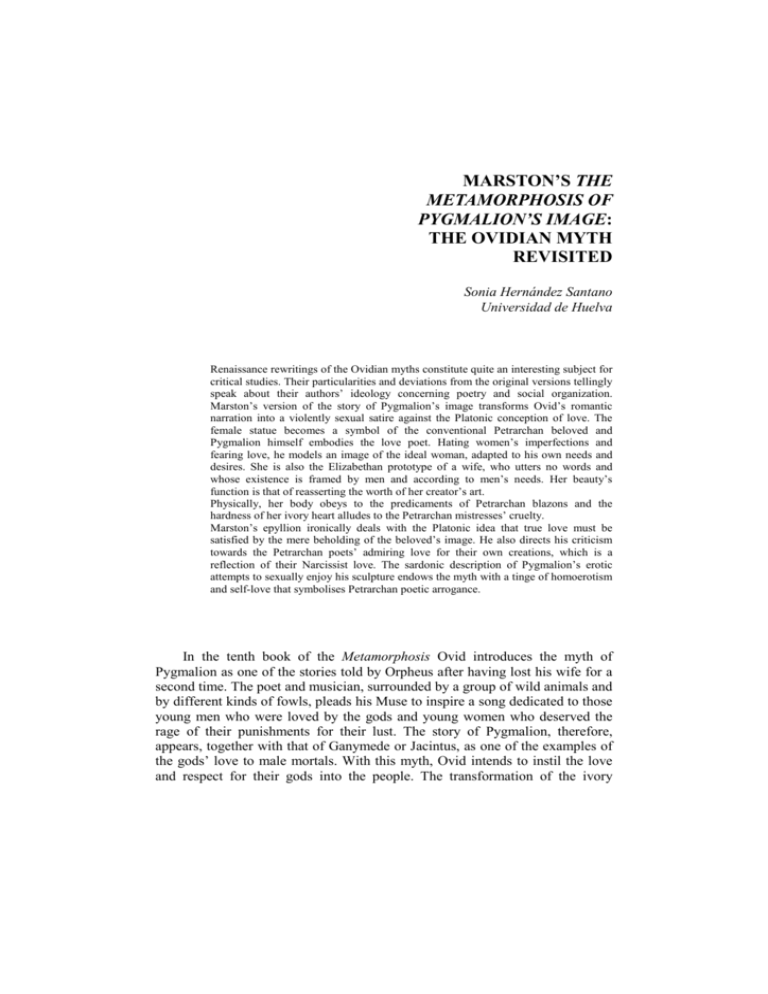
MARSTON’S THE
METAMORPHOSIS OF
PYGMALION’S IMAGE:
THE OVIDIAN MYTH
REVISITED
Sonia Hernández Santano
Universidad de Huelva
Renaissance rewritings of the Ovidian myths constitute quite an interesting subject for
critical studies. Their particularities and deviations from the original versions tellingly
speak about their authors’ ideology concerning poetry and social organization.
Marston’s version of the story of Pygmalion’s image transforms Ovid’s romantic
narration into a violently sexual satire against the Platonic conception of love. The
female statue becomes a symbol of the conventional Petrarchan beloved and
Pygmalion himself embodies the love poet. Hating women’s imperfections and
fearing love, he models an image of the ideal woman, adapted to his own needs and
desires. She is also the Elizabethan prototype of a wife, who utters no words and
whose existence is framed by men and according to men’s needs. Her beauty’s
function is that of reasserting the worth of her creator’s art.
Physically, her body obeys to the predicaments of Petrarchan blazons and the
hardness of her ivory heart alludes to the Petrarchan mistresses’ cruelty.
Marston’s epyllion ironically deals with the Platonic idea that true love must be
satisfied by the mere beholding of the beloved’s image. He also directs his criticism
towards the Petrarchan poets’ admiring love for their own creations, which is a
reflection of their Narcissist love. The sardonic description of Pygmalion’s erotic
attempts to sexually enjoy his sculpture endows the myth with a tinge of homoerotism
and self-love that symbolises Petrarchan poetic arrogance.
In the tenth book of the Metamorphosis Ovid introduces the myth of
Pygmalion as one of the stories told by Orpheus after having lost his wife for a
second time. The poet and musician, surrounded by a group of wild animals and
by different kinds of fowls, pleads his Muse to inspire a song dedicated to those
young men who were loved by the gods and young women who deserved the
rage of their punishments for their lust. The story of Pygmalion, therefore,
appears, together with that of Ganymede or Jacintus, as one of the examples of
the gods’ love to male mortals. With this myth, Ovid intends to instil the love
and respect for their gods into the people. The transformation of the ivory
S. Hernández
260
sculpture of a beautiful woman into a real human being is presented by the
Latin poet as a reward for Pygmalion’s confidence in Venus’ might. After
having participated in the celebrations of Venus’ festivity, the most important
event of the year in Cyprus, the sculptor prays before the goddess’ altar that he
can find an identical wife to the image he had created. Ovid wants to emphasise
the youth’s respect for Venus by presenting him cautious, not daring to require
a miraculous transformation:
.... Vouchsafe,
O Gods, if all things you can grant, my bride
Shall be’ —he dared not say my ivory girl—
“The living likeness of my ivory girl.”1
Venus then carries out the metamorphosis as a display of sympathy for
those who acknowledge her power.
The transformation narrated in this story, of a female stone image into a
flesh and blood woman, contrasts with the tale Orpheus tells in the preceding
lines. The Propoetides, “obscene” women, according to Ovid (10. 287), dared
deny Venus’ divinity and were punished with the opposite of the
metamorphosis of Pygmalion’s sculpture; they were turned from women into
“stones of flint” (10. 292). Not only is the Latin poet concerned with religious
teaching, but he also deals with the controversial commonplace of the worth of
artistic creation. He censors the disappearance of the barriers between art and
reality and mocks the sculptor for perceiving his work of art as a real being. The
excessive cares Pygmalion offers the ivory woman are sometimes rendered
ridiculous: “The firm new flesh beneath his fingers yields, / And fears the limbs
may darken with a bruise” (311-312). In the whole passage that describes how
he woos the senseless image, his love is treated as a kind of schizophrenia:
“Kisses he gives and thinks they are returned” (309). Simultaneously, he praises
the power of art and imagination to modify reality. Pygmalion himself
experiences a transformation by art because he stops rejecting womankind when
he succeeds in creating the ideal wife. Apart from meaning a criticism of the
exaggerated emphasis on art and imagination over reality, this passage stands as
a metaphor of dainty lovers who satisfy their anxieties by means of fantasy and
turns out to be an ironic mock of the courting of arrogant women who deny
sexual encounters. But Ovid is not just the pragmatist he shows to be in these
lines for he also displays all the subtlety of his verse to delight the reader with
the erotic description of the beloved’s nakedness and of the first encounter
between the two lovers once she has become human. In general, he conceived
the myth from a sympathetic point of view. Although his text is the most
1
Translation by Geoffrey Miles (2000: 346-349).
Marston’s The Metamorphoses…
261
ancient known source of the story, similar tales had also been written by the
Christian Greeks Clement of Alexandria and Arnobius of Sicca; they employed
them as negative examples with the intention of denouncing the harmful effects
of art and of censoring pagan idolatry.
Marston’s account of the myth preserves to a great extent both the Greek
and Ovidian attitudes, though shaped according to Elizabethan parameters. He
borrows the most critical elements from these two traditions and transforms
them into a harsh satire against the poetic uses of his time or about several other
subjects of controversy. This is in general the Renaissance tendency to
apprehend the story; authors as John Pettie in his “Pygmalion’s friend and his
image” (1576) or Richard Brathwait in his satire “On Dotage” (1621) also take
it as a vehicle to criticise human vice. Their versions have in common the sordid
narration of Pygmalion’s relationship with a senseless being; far from being
referred to as a romantic episode, as Ovid’s subtle verse succeeds in doing
despite some ironic moments, his love for the statue appears as a kind of
perversion in all of them.
Marston’s erotic epyllion is certainly the most original one because of its
ambiguity and powerful diction, in spite of the fact that it was considered
pornographic by his contemporaries. He justifies the violence of the poem’s
eroticism arguing that he had intended to create a satirical parody of
contemporary poetry, probably of the epyllion and Petrarchan sonnet sequences:
…deem’st that in sad seriousness I write
Such nasty stuff as is Pygmalion,
Such maggot-tainted lewd corruption?
Hence, thou misjudging censor: know I wrote
Those idle rhymes to note the odious spot
And blemish that deforms the lineaments
Of modern poesy’s habiliments. (Satire 6)
However, the poem maintains a balance between seriousness and humour
that questions Marston’s real intention when writing such lascivious verse. The
conflicts of representation of the female body by means of the rhetoric of desire
that undermine Petrarchan poetry appear to be the main subject of reflection in
the epyllion.
In the dedication “To his Mistress” the poet declares his intention to
persuade her to grant sexual favours to him. He argues that his anxieties are
literary, better than fleshy, because he does not want his verse to describe
fanciful events in the manner of Petrarchism. His Muse inspires him lascivious
lines because he does not have real experiences to be references for them. A
parallelism is established between the expression of affected-invented love for
ethereal women which come into being only in the poets’ imaginations —for
S. Hernández
262
which Pygmalion’s passion stands as a metaphor— and Marston’s compelled
inclination to deal with love in hyperbolic terms. Marston, then, does not pray
his beloved to satisfy his sexual desire, but to perform an active, not figurative
—which is Laura’s function in Petrarch’s sonnets—, role in the inspiration of
poetry. Of course, there is some irony in this argumentation because, after all,
he demands sex. In the first line he complains of his “wanton Muse,” making
use of the two main meanings of the adjective, and accuses her not only of
lewdness, but also of lack of poetic discipline in bringing forth feigned stories;
the beloved’s active participation is therefore required to convey reason to the
composition:
My wanton Muse lasciviously doth sing
Of sportive love, of lovely dallying.
O beauteous angel, deign thou to infuse
A sprightly wit into my dulled Muse.
I invocate none other saint but thee
To grace the first blooms of my poesy.
Thy favours, like Promethean sacred fire,
In dead and dull conceit can life inspire,
Or, like that rare and rich elixir stone,
Can turn to gold my leaden invention. (1-10)
Though masked under the veil of poetic concern, the must to persuade the
beloved to grant sexual favours becomes the main reason for this literary
exercise. In line 8, the wish that “dead and dull conceit” could be inspired life
by means of her favours mirrors the transformation of Pygmalion’s inanimate
work of art, carried out by Venus with the main intention to make them
celebrate her might by means of performing “that action” she “seeks and ever
doth require,” as Marston states in line 195. In fact, sex is the first thing they do
when they meet each other as two human beings. This narrative echo in line 8
conceals a desire to see his own art, his poetry, also transformed into reality.
The beloved is endowed with Venus’ power (“Be gracious then, and deign to
show in me / The mighty power of thy deity,” 11-12) not only to inspire art with
life —his verse with lively conceits— but also to grant him the state of sexual
satisfaction he needs to write about experienced events by contrast with
Petrarchan idealisation of unfulfilled desires. That is why he pleads the lady not
to force him to envy Pygmalion (14). And when he be given the material to
write about, he will be able to conceive lively poetry: “Then when thy kindness
grants me such sweet bliss, / I’ll gladly write thy metamorphosis” (15-16).
The metamorphosis of the ivory image, as these lines denote, has been
interpreted by Marston as a metaphor of the conquest of the stony Petrarchan
mistress. The idea that art and poetry become meaningful activities when they
succeed in modifying reality, in “moving” the audience, appear to be the
Marston’s The Metamorphoses…
263
message of this version of the classical fable. In his Defense of Poesy, Philip
Sidney enhanced this function of the act of poetic creation: “for these indeed
[poets] do meerely imitate, and imitate both to delight and teach, and delight to
move men to take that goodness in hand ” (Kimbrough 1983: 111).
Poetry should be a source of delight and, at the same time, move the
passive audience to action. Similarly, Marston emphasises over the course of his
poem art’s effect as a catalyst of action; Lynn Enterline (2000: 125) calls the
reader’s attention over the frequent appearance of the Ovidian verb “to move”
(mouere) to refer to Pygmalion’s inability to awaken sympathy (“his dull
Image, which no plaints could move,” 78); to define the aim of Pygmalion’s
prayer (“thus having said, he riseth from the floor…Hoping his prayer to pity
moved some power,” 147); to describe the statue’s awakening (“he found that
warmth, and wished heate / Which might a saint and coldest spirit move,” 220);
or to refer to the main aim of Petrarchan poetry (“Tut, women will relent /
Whenas they find such moving blandishment,” 173-174).
Apart from being a satire of Petrarchan static love and affected poetic
expression, the poem also deals with the Platonic opposition between Art and
Nature, appearance versus substance. This view of the myth proceeds from
Clement of Alexandria, who censors idolatry and the harmful power of art:
We must, then, approach the statues as closely as we possibly can in order to
prove from their appearance that they are inseparably associated with error.
For their forms are unmistakably stamped with the characteristic marks of the
daemons... Such strength had art to beguile that it became for amorous men
guide to the pit of destruction.2 (Exhortation to the Greeks)
Marston’s treatment of the Platonic opposition to art is conflictive. At the
beginning of the story Pygmalion appears to deserve censorship because he
loves the image, not the bodiless essence of women, as Petrarchan poets,
unavoidably, do. Conscious of the many faults of womankind, he creates a
representation of what he would like women to be. He makes up his own reality
and loves it: “Yet Love at length forced him to know his fate, / And love the
shade whose substance he did hate” (5-6). This is for Astrophil, the suffering
lover in Sidney’s sonnet sequence, the main mistake of worldly love: “what we
call Cupid’s dart, / An image is, which for our selves we carve” (5. 5-6).
Pygmalion’s attitude opposes Plato’s interpretation of reality as the ethereal
substance of which we can only see feigned images. And differs from Bembo’s
account of virtuous love, that is, love of the inner self instead of physical
appearance (The Book of Courtier 4). The artist takes advantage of his ability to
feign reality and shelters in a world of his own invention. However, despite the
2
Translation by Geoffrey Miles (2000: 348-349).
S. Hernández
264
fact that he admires women’s image, not their soul, as it is supposed to be the
case of Petrarchan poets, his love has parallelisms with theirs. Both adore the
product of a subjective interpretation of reality. Though their feelings differ in
their targets —the latter love the spirit and Pygmalion the body of women—,
their love procedures coincide. The beloved is represented from the male point
of view, and she is always an absent presence. Pygmalion’s love for a sculpture
is conceived as a metaphoric hyperbole of Petrarchan unfruitful passion.
But the material inclinations of his feelings do not constitute the most
offensive feature of it. It is his ability to model an own world adapted to his
needs what actually enters into conflict not only with the Petrarchan philosophy
of love, but also with the Protestant idea of predestination. English Calvinism
promulgated human inability to forge their destiny, to change God’s plans
concerning the Final Judgement of their sins. Men and women were not allowed
to work in life for a better end and were doomed to accept a passive role in the
trip towards salvation or condemnation. Pygmalion transgresses the role of God
the creator. He dares modify reality according to his needs exerting the power to
invent a new Nature that Aristotle and Horace ascribed to poets, in opposition to
the Platonic theory of divine inspiration (furor poeticus). He fulfils Sidney’s
expectations in Defense about the poets’ ability to create an original world,
reflecting not what it really is but what it should be: “Only the poet, disdaining
to be tied to any subjection, lifted up with the vigor of his own invention, doth
grow in effect into another Nature, in making things either better that Nature
bringeth forth” (Kimbrough 1983: 108).
Pygmalion identifies with this conception of the artists’ might:
For having wrought in purest ivory
So fair an image of a woman’s feature,
That never proudest mortality
Could show so rare and beauteous a creature
...
He was amazed at the wondrous rareness
Of his own workmanship’s perfection.
He thought that Nature ne’er produced such fairness… (7-10, 13-15)
This conception of the poets’ creative potential contrasts with the poetic
humbleness of Petrarchan lovers who, influenced by the Neoplatonic trust in
divine inspiration, appeal to their mistresses’ motivation to produce verse.
Though he conceives an anti-Petrarchan character in this respect, Marston
himself appears as one of them in the dedication to his beloved.
Despite this Aristotelic aspect of his persona, Pygmalion embodies the
Neoplatonic poetic style. Marston’s Metamorphosis begins by developing a
satiric parody of Petrarchan clichés by means of the hyperbole. The stoniness of
Marston’s The Metamorphoses…
265
the mistress, a conventional motif of complaint referred to her heart’s cruelty, is
literally interpreted in the poem, and applied to her whole ivory body. The
blazon becomes an instrument for criticism; it mocks, on one hand, the
Petrarchan fanciful and affected descriptions of their ladies obeying the
European canons of beauty and, on the other, their worn out tropes and images.
It plays with the sculptor’s inability to discern what is natural or artificial
establishing parallelisms between the well-known features of Petrarchan
mistresses and the outward properties of ivory:
Her breasts like polished ivory appear,
Whose modest mount do bless admiring eye,
And makes him wish for such a pillowbere. (43-45)
Does Marston forget that he is describing a carving of ivory and then turns
to this simile driven by convention? He is likely to be mocking lovers’ selfdeception when they idealise their ladies’ bodies in their blazons. Pygmalion’s
alienation from reality makes him desire such a stony breast for a place where
to rest his head on. He also recognises in the brightness of polish the “beams /
Which shoot from out the fairness of her eye” (29) and “her amber-coloured,
her shining hair” (31). The whiteness of the material from which she was
modelled gives her face the paleness of beauty: “Such red and so pure white /
Did never bless the eye of mortal sight” (35-36). Redness could be one more
element of his fantasy. And when Pygmalion’s sight arrives to her pubes, to
“Love’s pavilion” (50) or Venus’ “chiefest mansion” (50), the blazon turns into
a parody of poets’ ridiculous feigned decency when describing such an
important element for love: “There he would wink, and winking look again; /
Both eyes and thoughts would gladly there remain” (53-54). Marston compares
their affectation to that of devout women who pretend not to look at what
provokes sinful thoughts in them:
Whoever saw the subtle city dame
In sacred church, when her pure thoughts should pray,
Peer through her fingers, so to hide her shame,
When that her eye her mind would fain bewray.
So would he view, and wink, and view again. (55-59)
Marston censors the hypocrisy of the conventional resource to elude
describing these parts but not without mentioning their existence. Instead of
simply skipping them, poets usually call the readers’ attention to the narrative
ellipsis decorum obliges them to perform. In The Countess’ of Pembroke
Arcadia (2. 11), Sidney apologises for having to omit the best parts in his
description of Philoclea’s beauty: “Loth, I must leave his chief resort. / For such
a use the world hath gotten, / The best things still must be forgotten.” Similarly,
Marston mocks the ladies’ affected shame: “He wondered that she blushed not
when his eye / Saluted those same parts of secrecy” (61-62); as it happens to be
S. Hernández
266
the reaction of Sidney’s muse when, after describing some of Stella’s qualities,
she is required to sing about her best attributes: “Yet ah, my maiden Muse doth
blush to tell the best” (77. 14).
Another subject of criticism in the epyllion is Petrarchan poets’ Narcissist
love for the written images they themselves create; marked by the outward
expression of heterosexual love, their passionate verse has the only purpose of
claiming for the recognition of artistic worth. Mistresses’ representations do not
embody real ladies, but the result of the artists’ creative efforts to stand out for
their genius. Marston places continuous emphasis on Pygmalion’s authorship
and repeats comments such as: “And thus, enamoured, dotes on his own art”
(71) or “he finds how he is graced / By his own work” (172-173). The perfect
correspondence between the two bodies, when Pygmalion amorously embraces
the ivory sculpture, alludes to the unilateral character of their relationship. Her
members are continuations of his because he has created them:
His eyes her eyes kindly encountered,
His breast her breast oft joined close unto,
His arms’ embracements oft she sufferedHands, arms, eyes, tongue, lips, and all parts did woo.
His thigh with hers, his knee played with her knee.
A happy comfort when all parts agree. (97-102)
It is evident that all parts agree because all of them are coordinated by the
same person. And when he goes to bed with the senseless woman, her passivity
is taken for granted as the meaningful silence of the Petrarchan mistress —
whose existence, not active presence— is all the poet requires to carry out the
representation of his poetic abilities. Marston ironically uses the plural pronoun
to denounce the unbalanced relationship: “Now they dally, kiss, embrace
together” (161). It is not them, but he, who perform all these amorous actions.
The complexity of this version of the Ovidian myth of Pygmalion lays on
the ambiguity of the satire. Because, on one hand, Marston intends to distance
himself from Petrarchan poetic conventions by means of a parodying
description of the youth’s pathological love, but on the other, he insists on
identifying himself with this discourse. He envies Pygmalion’s freedom to
enjoy his lady’s beauties: “O that my mistress were an image too, / That I might
blameless her perfections view!” (65-66). He acknowledges the advantages of
the Petrarchan free manipulation of the lady’s body. However, he explicitly
laughs at those lovers who assume the Platonic conception of love, that is, love
without sex:
I oft have smiled to see the foolery
Of some sweet youths, who seriously protest
Marston’s The Metamorphoses…
267
That love respects not actual luxury,
But only joys to dally, sport and jest. (109-112)
Because he knows that “Love’s eyes in viewing never have their fill” (42).
Apart from these changes in the point of view of the narrator that make the
reader doubt whether he mocks Petrarchists or he is one of them, the most
troublesome passage in the poem is the narration of the metamorphosis of the
image into a real woman and of the two lovers’ encounter. If Marston wrote an
almost pornographic portrait of the sculpture’s nakedness and Pygmalion’s
sexual abuses, once he is dealing with the body of a real woman, his poetry
requires the limitations of decorum: “Peace, idle poesy, / Be not obscene,
though wanton in thy rhymes.” (225-226). Although a sexual intercourse takes
place in the course of the poem, the author denies giving a detailed report of
what “is not fit reporting” (210). This sudden show of decency makes Lynn
Enterline (2000: 138) identify Pygmalion with Marston because, if the former
“loathes female substance”, the latter “is equally averse to having any truck
with it.” From the moment she becomes an actual woman, the development of
actions in the poem is quickened; the narrator draws the curtain of censorship to
avoid having to mention certain facts, and appeals to the readers’ imagination to
portrait what happened between the lovers:
Let him conceit but what himself would do
When that he had obtained such favour
Of her to whom his thoughts were bound unto,
...
Could he abstain midst such a wanton sporting
From doing that which is not fit reporting?
...
What he would do, the selfsame action
Was not neglected by Pygmalion. (199-201, 209-210, 215-216)
Marston, therefore, unveils at the end of the poem a Petrarchan conception
of poetic creation, which has been continuously struggling to dominate the
narrative process. Whether he intended to parody the commonplaces of
Renaissance poetry or not, he now appears to accept Elizabethan social and
stylistic precepts. He finally becomes identifiable with the Petrarchan inability
to represent the female body —which is, according to Enterline (2000: 139)
“the poem’s closing idea.”
S. Hernández
268
BIBLIOGRAPHY
Enterline, Lynn 2000: The Rhetoric of the Body. From Ovid to Shakespeare. Cambridge,
Cambridge University Press.
Marston, John (1598) The Metamorphosis of Pygmalion’s Image.> Miles, G. ed.
Miles, Geoffrey 2000: Classical Mythology in English Literature. A Critical Anthology.
London, Routledge.
Kimbrough, Robert ed. 1983: Sir Philip Sidney Selected Prose and Poetry. London, The
University of Wisconsin Press.

